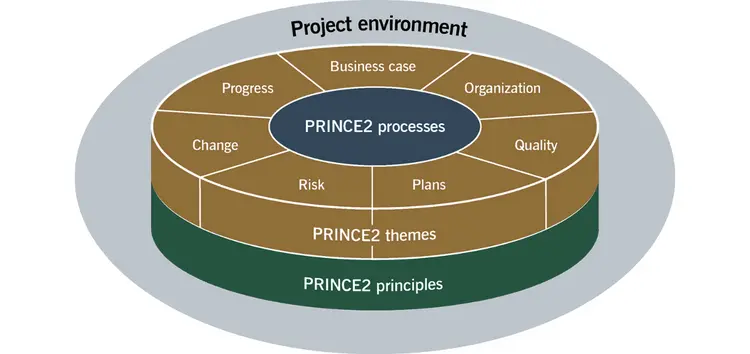PRINCE2: The Evolving Framework for Project Success in a Dynamic World

In an era defined by rapid technological change and economic uncertainty, the ability to deliver projects successfully is a critical competitive advantage. Yet, statistics consistently show that a significant percentage of projects still fail to meet their original goals, often due to scope creep, poor communication, and a lack of clear direction. In this challenging landscape, a structured, proven methodology is not a luxury—it’s a necessity. For countless organisations worldwide, the answer lies in PRINCE2.
But what exactly is this framework, and how is it evolving to stay relevant in the age of Agile and artificial intelligence? This article delves into the fundamentals of PRINCE2, explores its core components, and charts its exciting future.
What is PRINCE2? A Foundation of Control and Clarity
For anyone asking, what is PRINCE2?, the acronym provides the first clue. PRINCE2 stands for PRojects IN Controlled Environments. It is a process-driven, tailorable project management methodology that provides a structured framework for guiding a project from conception to closure.
Originally developed by the UK government for IT projects, it has since been refined into a generic, best-practice approach applicable to any project, regardless of type, scale, or industry. Its power lies not in being a rigid set of rules, but in providing a common language and a logical, organised system that can be scaled and adapted to a project’s specific needs.
At its heart, PRINCE2 ensures that a project is justified by a business case, has a defined customer, and involves a clear organisation structure with dedicated roles and responsibilities. It answers the fundamental questions that plague many projects:
- Why? Why are we doing this project? (Business Case)
- What? What are the end products and quality expectations? (Scope & Quality)
- Who? Who is involved and what are their responsibilities? (Organization)
- How? How will we manage risk, issues, and changes? (Controls)
- When? What is the plan and timeline? (Plans)
The Three Pillars of the PRINCE2 Methodology
The PRINCE2 framework is built upon three interconnected pillars that provide its comprehensive structure: Principles, Themes, and Processes.
The 7 Principles: The Universal Guiding Rules
These are the guiding obligations that underpin the entire methodology. A project cannot claim to be using PRINCE2 if it ignores these principles. They are:
- Continued Business Justification: There must be a justifiable reason for the project to start and, crucially, to continue.
- Learn from Experience: Project teams should continually seek and apply lessons from previous projects and the current one.
- Define Roles and Responsibilities: Everyone involved must understand their roles, responsibilities, and accountability.
- Manage by Stages: Projects are planned, monitored, and controlled stage by stage.
- Manage by Exception: A hierarchy of authority is established, defining tolerance limits for delegation.
- Focus on Products: The project must focus on the delivery of defined products (outputs) and their quality.
- Tailor to Suit the Project: The methodology must be scaled and adapted to the project’s environment, size, complexity, and risk.
The 7 Themes: The Ongoing Areas of Focus
Themes are the aspects of project management that must be addressed continually throughout the project lifecycle. They represent the knowledge needed for effective project management.
- Business Case: The “why” that drives the project.
- Organization: The “who” – the defined structure of the project team.
- Quality: Defining what “good” looks like and ensuring it is achieved.
- Plans: The “how, when, and how much” – the roadmap for the project.
- Risk: Identifying, assessing, and controlling uncertainty.
- Change: Managing issues and potential changes to the project’s baseline.
- Progress: Monitoring and comparing actual achievements against the plan.
The 7 Processes: The Step-by-Step Journey
These processes provide a step-by-step progression from pre-project initiation to final closure. They define the activities to be carried out at each stage:
- Starting up a Project: Ensuring the project is viable.
- Directing a Project: Enabling the Project Board to make key decisions.
- Initiating a Project: Establishing a solid foundation for the project.
- Controlling a Stage: Managing day-to-day work by the Project Manager.
- Managing Product Delivery: Coordinating the team’s work on creating products.
- Managing a Stage Boundary: Planning the next stage and reporting on the last.
- Closing a Project: Bringing the project to a controlled end.
The Future of PRINCE2: Agile, Hybrid, and Digitally Enhanced
Some may wonder if a highly structured methodology like PRINCE2 has a place in today’s fast-paced, agile-driven world. The answer is a resounding yes. Its future is not one of replacement, but of evolution and integration. The core principles of PRINCE2 are more relevant than ever, but their application is becoming more dynamic.
The Rise of PRINCE2 Agile® and Hybrid Models
The most significant trend shaping the future of PRINCE2 is its powerful synergy with Agile. PRINCE2 Agile was specifically created to integrate the best of both worlds. In this hybrid model:
- PRINCE2 provides the governance framework at the project level, ensuring alignment with business objectives, managing risk, and providing the necessary control points for senior management.
- Agile methods (like Scrum or Kanban) are used at the delivery level, allowing teams to work iteratively, respond to change quickly, and deliver value incrementally.
This combination gives organisations the “best of both worlds”: the high-level control and business-case focus of PRINCE2, with the flexibility, speed, and customer collaboration of Agile. It effectively answers the common critique that PRINCE2 is too rigid, proving that its principle of “tailoring” is its greatest strength.
Leveraging AI and Advanced Project Management Tools
The digital transformation of project management is another key driver. AI-powered tools are now capable of forecasting risks, optimising resource allocation, and generating real-time progress reports. The structured nature of PRINCE2—with its clear plans, defined stages, and regular reporting requirements—makes it perfectly suited to be enhanced by this technology. The data generated by a well-run PRINCE2 project is clean, consistent, and ideal for AI analysis, freeing project managers from administrative burdens to focus on leadership, stakeholder engagement, and strategic problem-solving.
The Enduring Need for Governance and Soft Skills
As technical processes become more automated, the human elements of project management become more critical. The future PRINCE2 practitioner will be a strategic leader, not just an administrator. The framework’s emphasis on clear roles, business justification, and structured communication provides the perfect foundation for developing these essential soft skills—leadership, communication, negotiation, and emotional intelligence.
For a deeper dive into the specific updates in the latest version, this resource provides an excellent overview of what is PRINCE2? and its modern application.
To understand the broader context, this analysis of predicted trends in project management for 2025 and beyond highlights the very trends that PRINCE2 is perfectly positioned to address.
Conclusion: A Timeless Framework for a Changing World
PRINCE2 has earned its place as a global project management standard for a simple reason: it works. It provides a common-sense, organised approach to navigating complexity and uncertainty. Far from being a relic of a bygone era, its future is bright and dynamic. By embracing agility, integrating with digital tools, and fostering strong leadership, PRINCE2 is demonstrating its remarkable adaptability. For organisations and professionals seeking a proven path to project success, PRINCE2 remains an indispensable and evolving framework, ready to meet the challenges of tomorrow’s project landscape.

Source: PRINCE2: The Evolving Framework for Project Success in a Dynamic World




